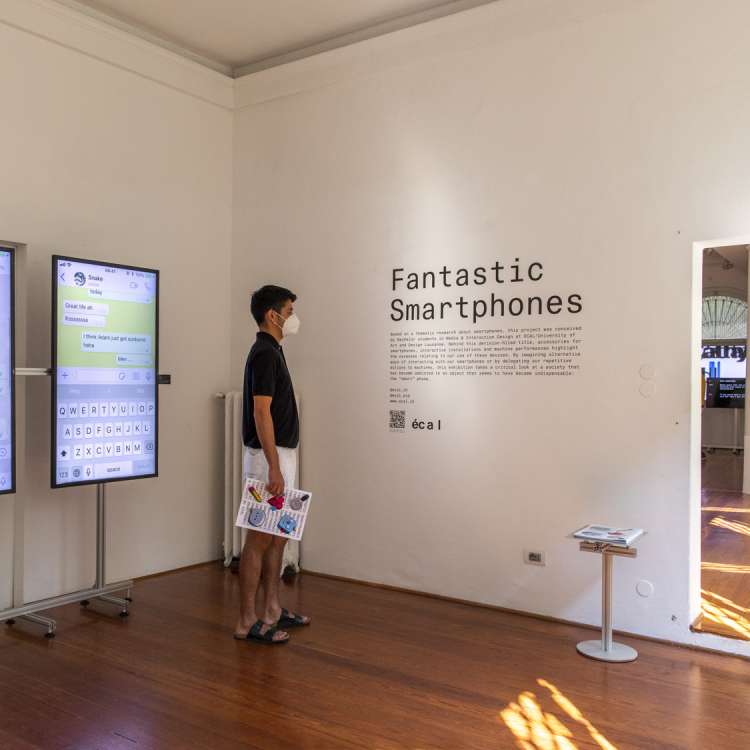
ECAL/University of Art and Design Lausanne
Fantastic Smartphones
Hours and dates
- From 4 Nov 2021 to 7 Nov 2021 / from 10:00 to 18:00
The place
Le Pavillon
About
ECAL/University of Art and Design Lausanne
ECAL is regularly ranked among the top 10 art and design schools in the world. Directed by Alexis Georgacopoulos, it offers six Bachelor's degree programs (Visual Arts, Film, Graphic Design, Industrial Design, Media & Interaction Design, Photography) and five Master's degree programs (Visual Arts, Film, Product Design, Photography, Type Design). It also offers a Propaedeutic Year that prepares students for entry into its departments and two Master of Advanced Studies in Design for Luxury & Craftsmanship and in Design Research for Digital Innovation (with the EPFL+ECAL Lab).
Medias
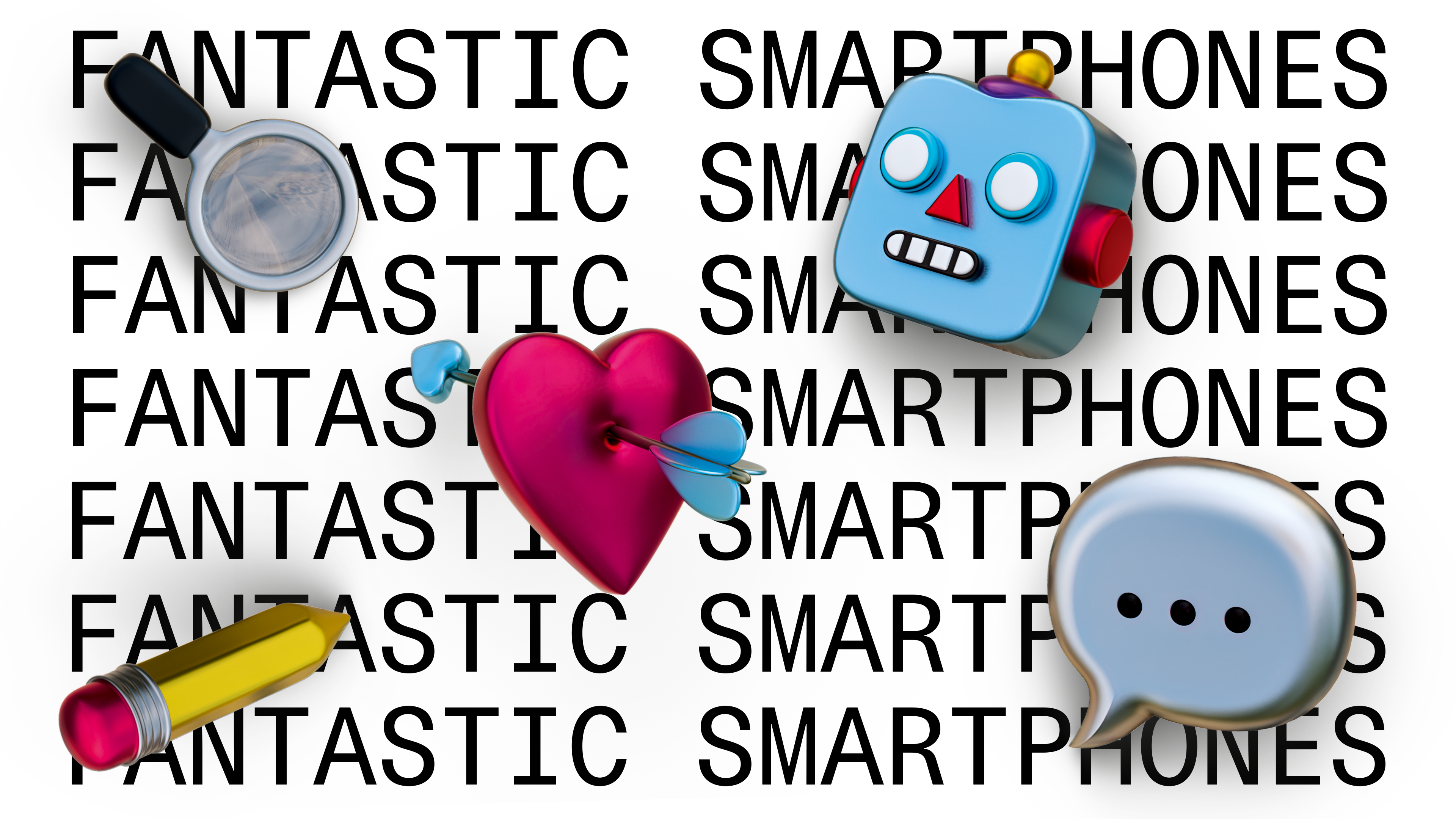
Fantastic Smartphones
ECAL/University of Art and Design Lausanne presents a series of projects and installations developed by Bachelor Media & Interaction Design students, that address our relationship with smartphones and the way they influence our daily behaviour.
Behind the derision-filled title Fantastic Smartphones, alternative accessories, interactive installations and machine performances highlight the excesses relating to our use of these devices.
By imagining innovative ways of interacting with our smartphones or by delegating our repetitive actions to machines, this exhibition takes a critical look at a society that has become addicted to an object that seems to have become indispensable : the “smart” phone.
Is this object, which was initially perceived as an extension, still a source of pleasure or has it become a source of alienation? Bachelor Media & Interaction Design students provide answers to this question through a series of installations that address different aspects of this issue in an original and immersive way. Visitors will be able to discover how to save time when using a dating app; cheat on their personal health data through bots; illustrate the time lost away from their phone; attend a discussion between two smartphones; scroll to infinity in a mesmerising way; discover neologisms relating to new digital behaviours; free themselves from digital addictions; discover what really happens in the cloud thanks to a visual allegory; or witness the strange choreography of a robotic arm that takes pictures of itself with a selfie stick.
This event is part of the 200th anniversary of ECAL (1821-2021). With the support of Wallonia-Brussels International.
Medias
Automac
The digital world is omnipresent and has inserted itself into our most intimate relationships. The democratisation of dating applications such as Tinder has radically changed our social interactions. Built around a simple mechanism, Tinder reduces the act of dating to a single swipe. This slide of the finger to the right or the left is enough to show our interest or disinterest in a profile that comes up. Although high-stakes, even when performed repeatedly, this movement can become purely mechanical and lose its meaning. As its name indicates, Automač is a device that enables us to automatically match with a maximum number of potential partners on Tinder. The automaton consists of a smartphone holder, a camera that observes the screen and a rotating mechanism to swipe on the smartphone screen. Via a screen interface, the user has the possibility to choose selection criteria. By automating this process and delegating it to a machine, Automač positions itself as an optimal machine to have a maximum amount of matches in a minimum amount of time. This bias also highlights the excesses induced by this type of application. Catalogued and standardised in the form of a profile, individuals are reduced to the status of consumer products that are judged only by their formal attributes.
Project by : Antoine Barras, Guillaume Giraud. Teachers : Vincent Jacquier, Pauline Saglio
Medias
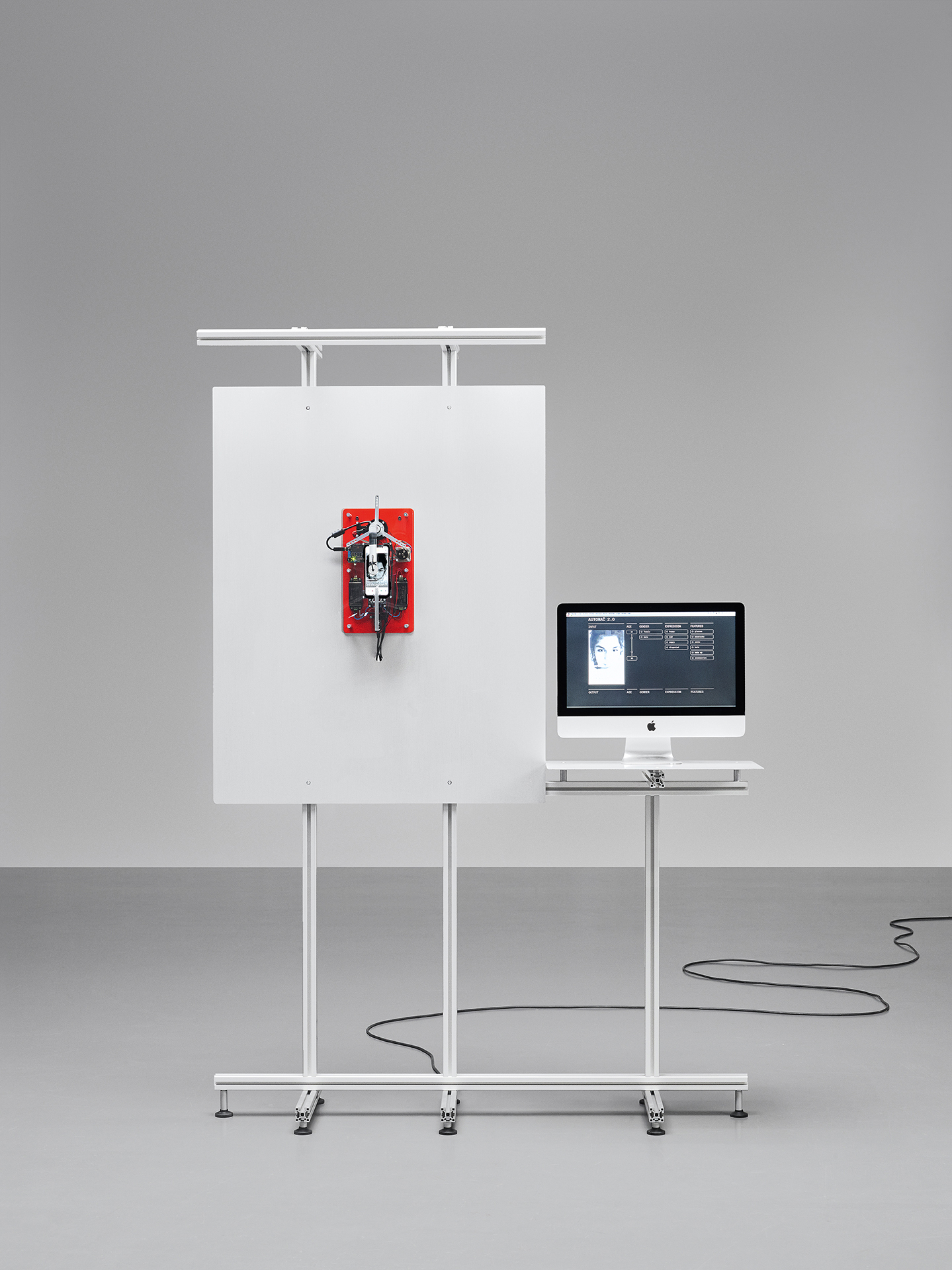
Biobots Overview
Biobots criticises the policy of large multinationals that collect and trade personal data through smartphones, relating to their customers’ health. Selling this information to certain institutions would have serious consequences. For example, a health insurance company could deny a claim to a person who, based on his or her personal data, might be deemed not to be working on their fitness sufficiently. By simulating the activity of a perfectly healthy individual, Biobots presents itself as a collection of objects of resistance to this collection of personal information, a scrambler that helps people keep control over their personal data.
Project by : Aurélien Pellegrini, Bastien Claessens, Evan Kelly. Teachers : Vincent Jacquier, Pauline Saglio.
Medias

Podobot
Project by : Aurélien Pellegrini, Bastien Claessens, Evan Kelly. Teachers: Vincent Jacquier, Pauline Saglio
Podobot is a motorised swing for smartphones. With this swinging movement, the automaton mimics the movement of a device in a person’s pocket while walking. The smartphone’s pedometer then captures a long walk at a steady pace and records this walking data in the application, simulating that the user is in good physical shape.
Medias
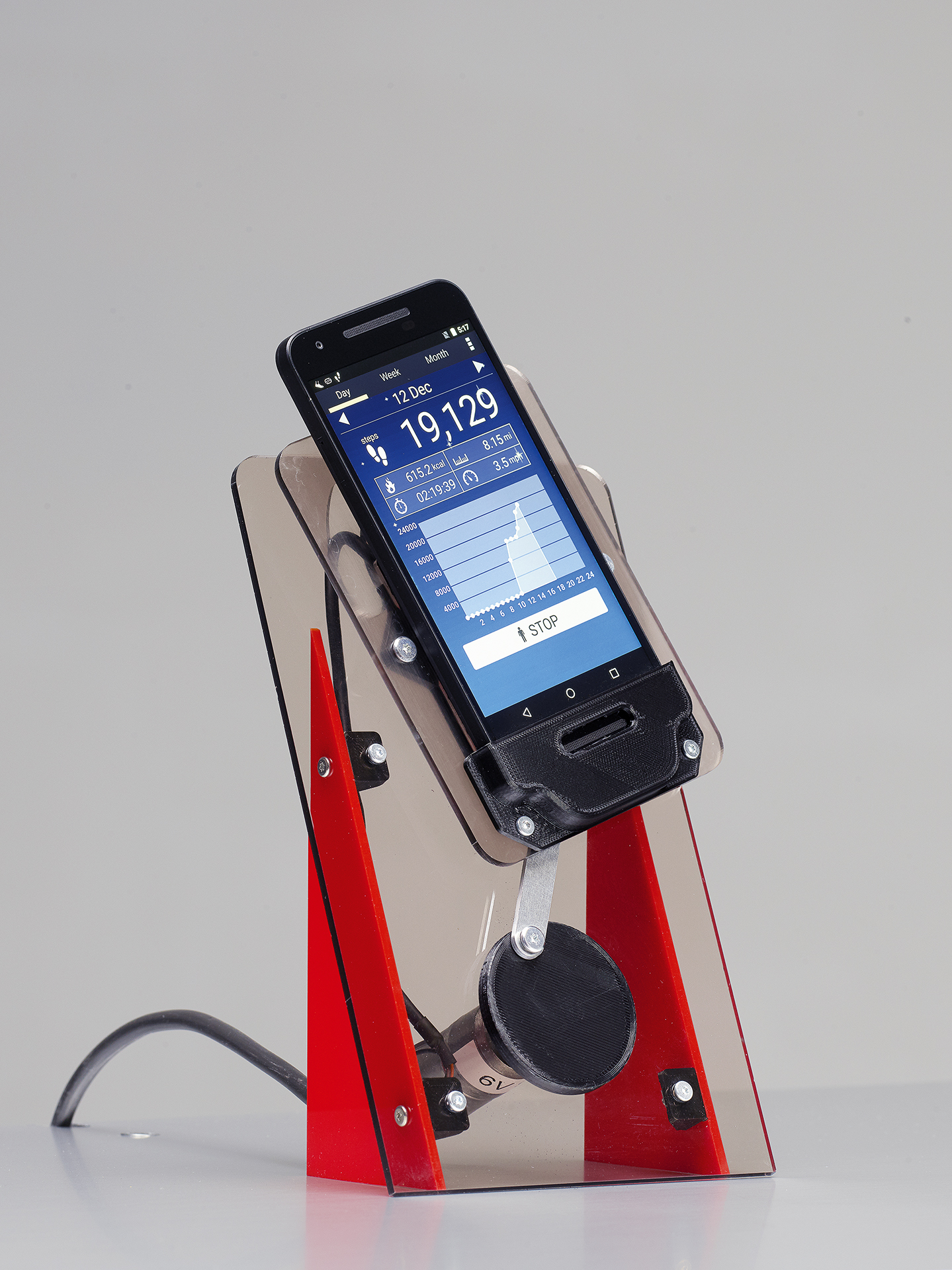
Cardiobot
Cardiobot is a device designed to fool a mobile application into studying your heart rate. Normally designed to process the video stream from a camera on the skin, the application analyses the frequency of shades of red seen by the camera as the blood passes through. Cardiobot reproduces this red sequence by spinning a disc covered with flat patches of different shades of red. The smartphone’s camera, which is then placed against the rotating disc, perceives subtle changes in the red tones. Since the speed of rotation of the disc is regular, the application deduces that the heart rate is very stable and healthy and records this data as that of the user.
Project by : Aurélien Pellegrini, Bastien Claessens, Evan Kelly. Teachers : Vincent Jacquier, Pauline Saglio.
Medias
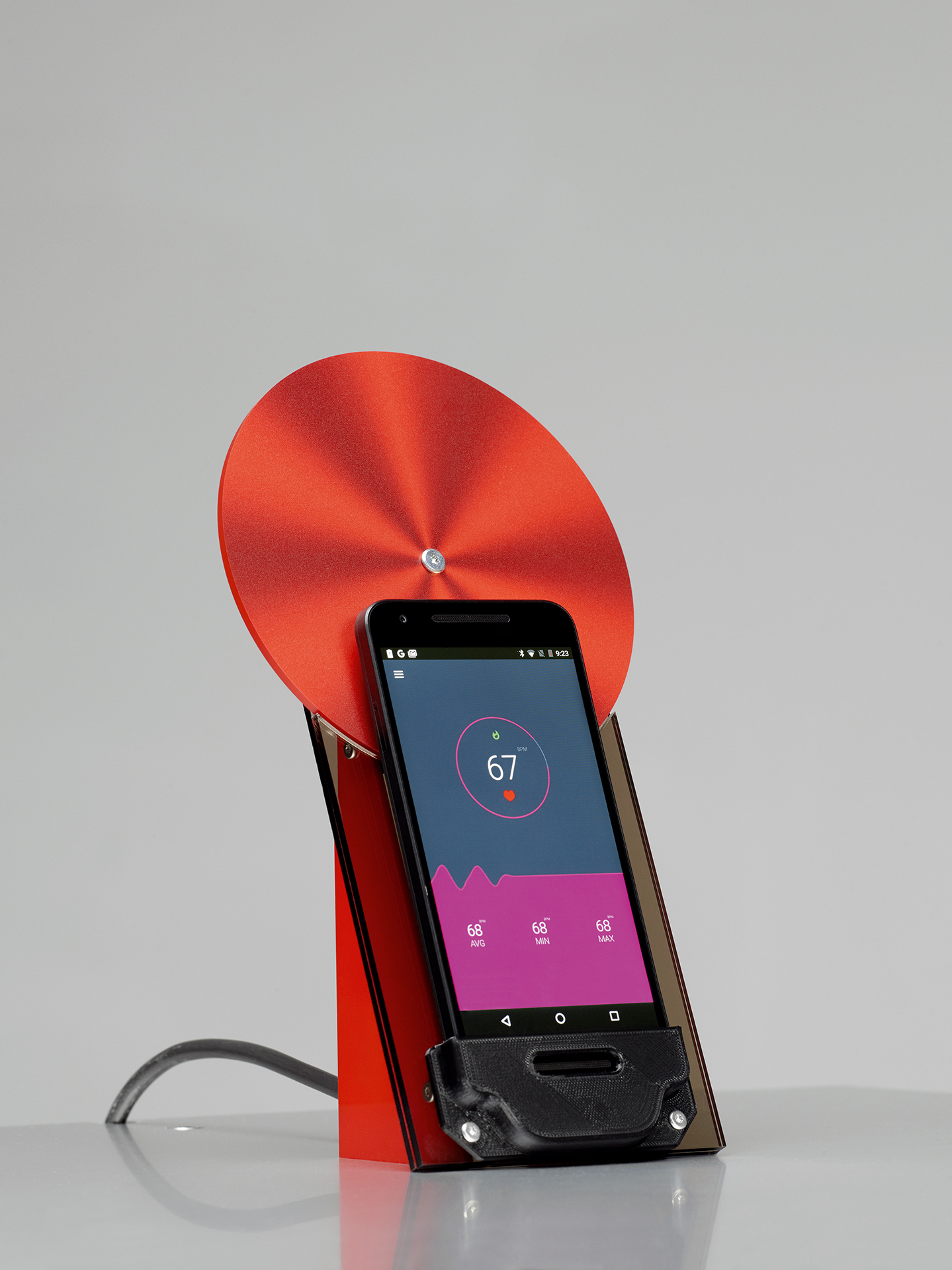
Sleepbot
Sleepbot is designed to house a smartphone under its glass cover to isolate it from ambient noise. Placed next to a speaker broadcasting white noise, it is immersed in a sound environment similar to that of a bedroom in which a person would be sleeping. At regular intervals the speaker emits noises that simulate the movements of a sleeping person during a shallow sleep phase. In such a context, the sounds captured by the smartphone are those of a perfect, restful sleep and make the user appear to have very good sleep patterns.
Project by : Aurélien Pellegrini, Bastien Claessens, Evan Kelly. Teachers : Vincent Jacquier, Pauline Saglio.
Medias
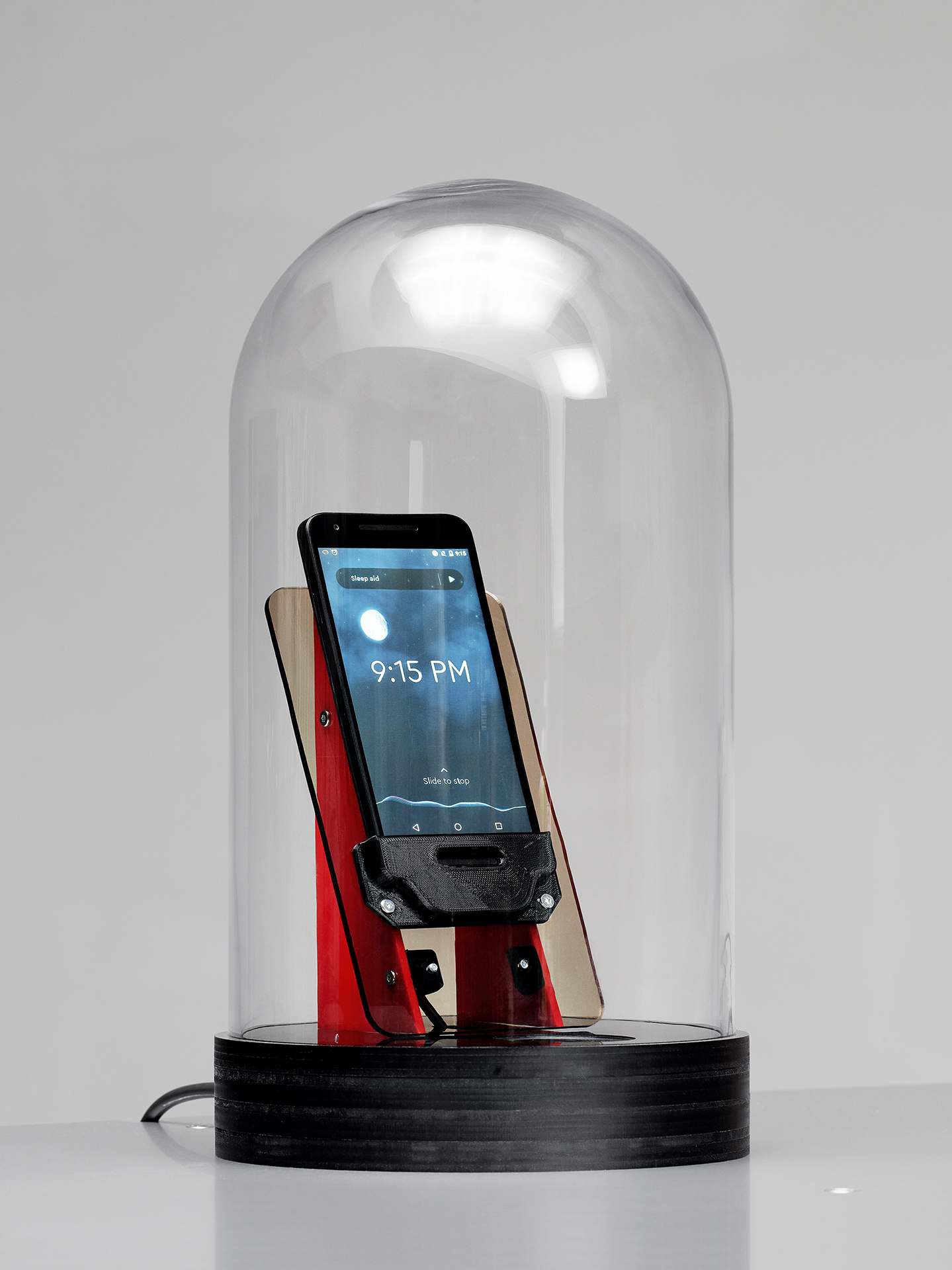
Meanwhile
Since the smartphone has become ubiquitous in our lives, our relationship with time is no longer the same and has become distorted. Our smartphones give us access to a huge amount of content designed to occupy our time. Once we are glued to the screen, time seems to pass so quickly. Conversely, parting with our smartphone sometimes feels like exposing ourselves to extreme boredom. This deep fear of emptiness creates a dependency, sometimes causing us to spend several hours a day staring at our screen in order to escape boredom. Meanwhile invites us to consider our relationship with time by inciting us to separate ourselves from our smartphone for a short while. While on stand-by, the screen of the automaton displays the words “insert your phone”, inviting visitors to slide their phone into the slot at the front. When a smartphone is inserted, it is sucked into the machine. From then on, a ticket indicating the time spent without the smartphone is printed out every second. Every now and then, it adds a sentence relating to the time that has past and the activities of the global digital networks. Finally, after a certain amount of time, the phone is released, and the machine’s screen displays “take your time”, inviting visitors to take the ticket and thus symbolically recover the time spent waiting. With ticket in hand, this accumulation of phrases with exorbitant figures puts into perspective the use we make of our smartphone: insignificant on a personal scale but frightening on a global scale.
Project by : Léonard Guyot, Maya Bellier, Paul Lëon. Professeurs : Vincent Jacquier, Pauline Saglio.
Medias
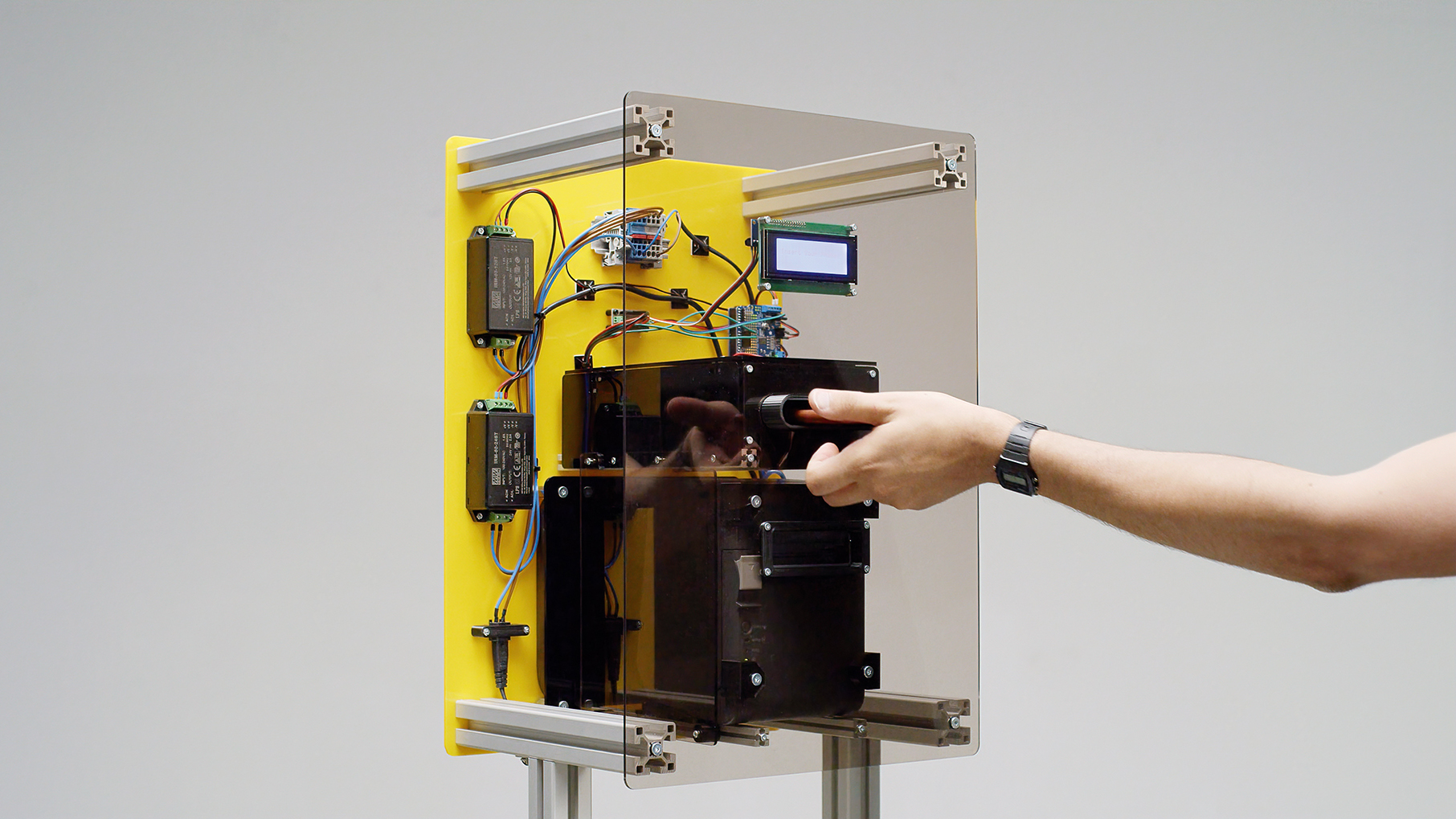
Taptaptap
Predictive text is a feature that aims to simplify text input on smartphones. Based on an analysis of our writing habits, our devices suggest a sequence of words that are supposed to match our writing style. Taptaptap exploits this feature to enable two machines to chat using only predictive text input. The device consists of a smartphone and mechanical fingers that select suggested words to form sentences. The principle is duplicated and used in a messaging application to enable two twin modules to converse. What kind of discussions can emerge from a dialogue whose sentences and lexicon are formatted and standardised by algorithms? Although devoid of communicative intent, this machine dialogue does not appear devoid of meaning, and sometimes even takes poetic turns.
Project by : Lisa Kishtoo, Bastien Mouthon, Diane Thouvenin. Professeurs : Vincent Jacquier, Pauline Saglio.
Medias
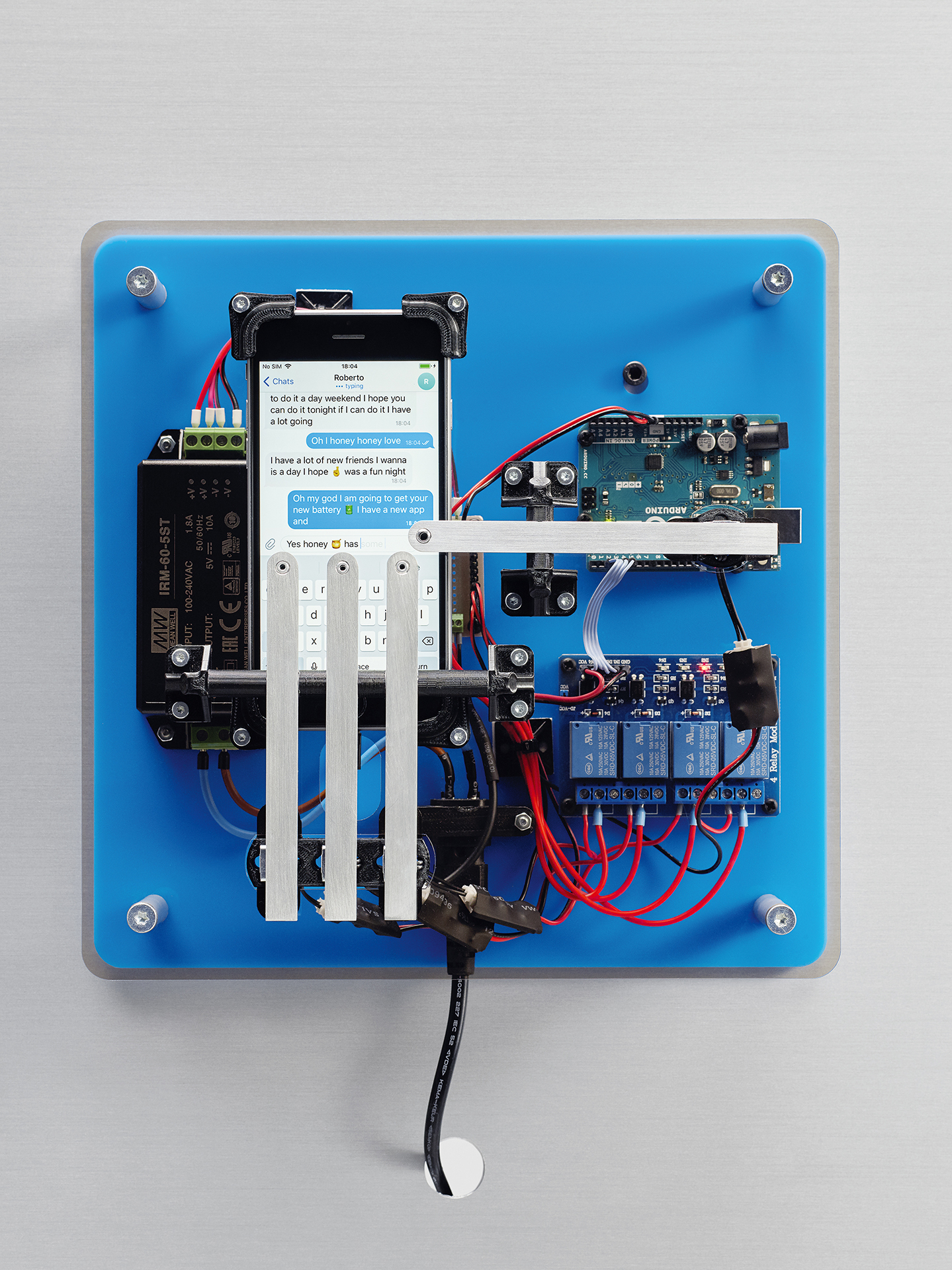
Kinetic Scroll
The Kinetic Scroll installation is a matrix of smartphones equipped with mechanisms that enable them to scroll endlessly. This wall echoes the social networks pages through which we sometimes scroll for hours. This set of moving screens represents, in the form of metaphorical choreography, contemporary crowds scrolling all together, but scrolling each for themselves. Scrolling endlessly, but what for? Scrolling for fear of missing an image that must be seen, but which will not be remembered ten images later. What do we hope to reach or what do we hope to escape from? This timeless kinetic installation with its regular rhythm seeks to hypnotise and capture attention like the continuous flow of images so emblematic of today’s interfaces.
Project by : Pablo Bellon, Kylan Luginbühl, Yaël Sidler. Teachers : Vincent Jacquier, Pauline Saglio.
Medias
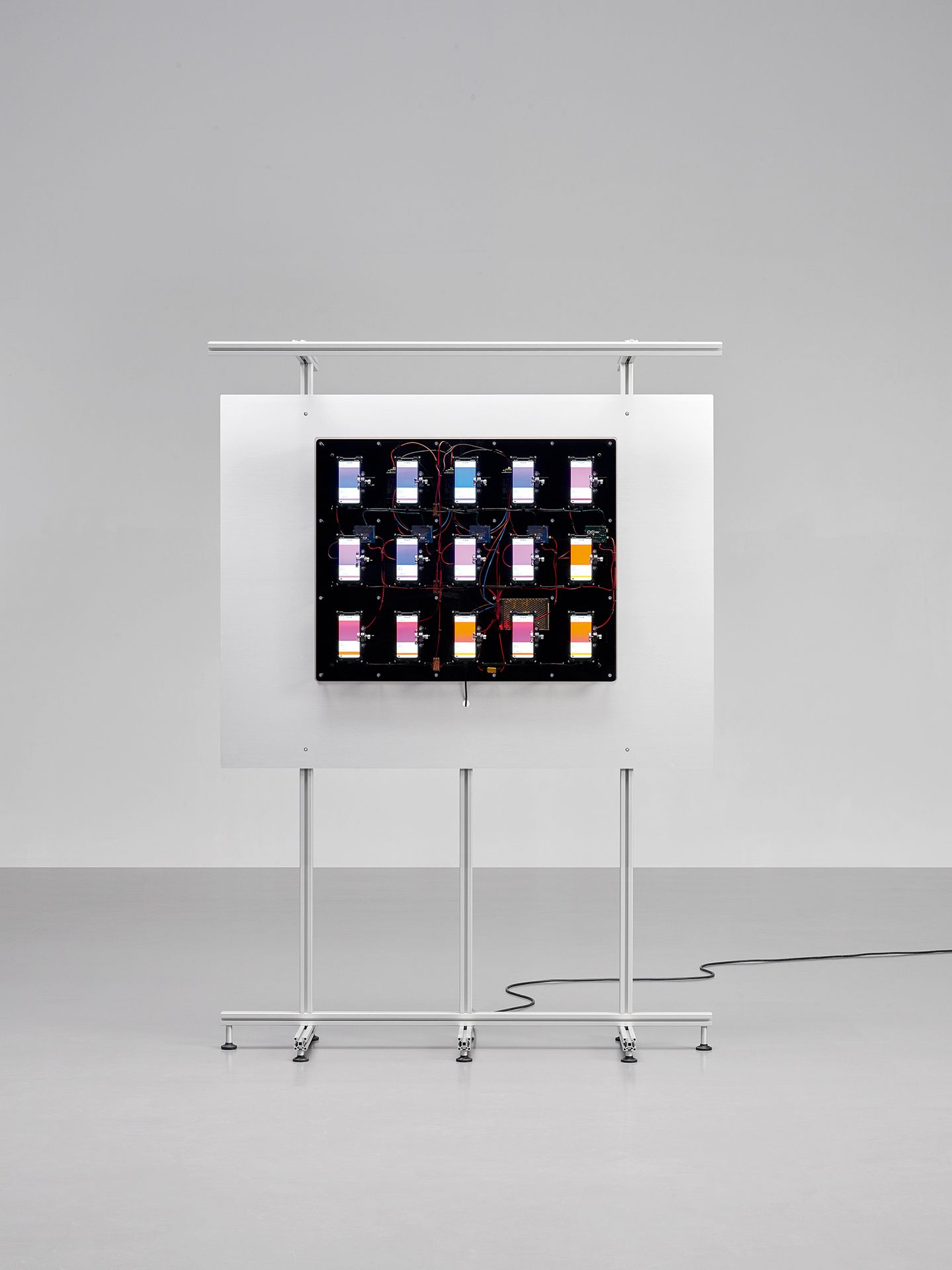
Adam & Eve
Adam & Eve is a recorded performance that revisits part of the famous story of the creation of Man and Woman according to biblical sources. A triptych of vertical screens stages the discussions that God, Eve and the Serpent might have had at the time of the birth of original sin. Transposed to our time, the three protagonists dialogue through an instant chat application. Each screen represents the smartphone view of one of the protagonists, enabling us to follow their ongoing discussions. This multi-view installation provides an omniscient view of the plot that links the three protagonists, the main issue of which is the temptation for Eve to transgress the rule of the Garden of Eden by tasting the forbidden fruit. This tableau drives us to reflect on the ways current communication systems are used and the drifts that may result from them.
Project by : Nora Fatehi, Michael Pica, Jorge Reis. Teacher : Roel Wouters. Assistants : Laura Nieder, Callum Ross, Tibor Udvari.
Medias
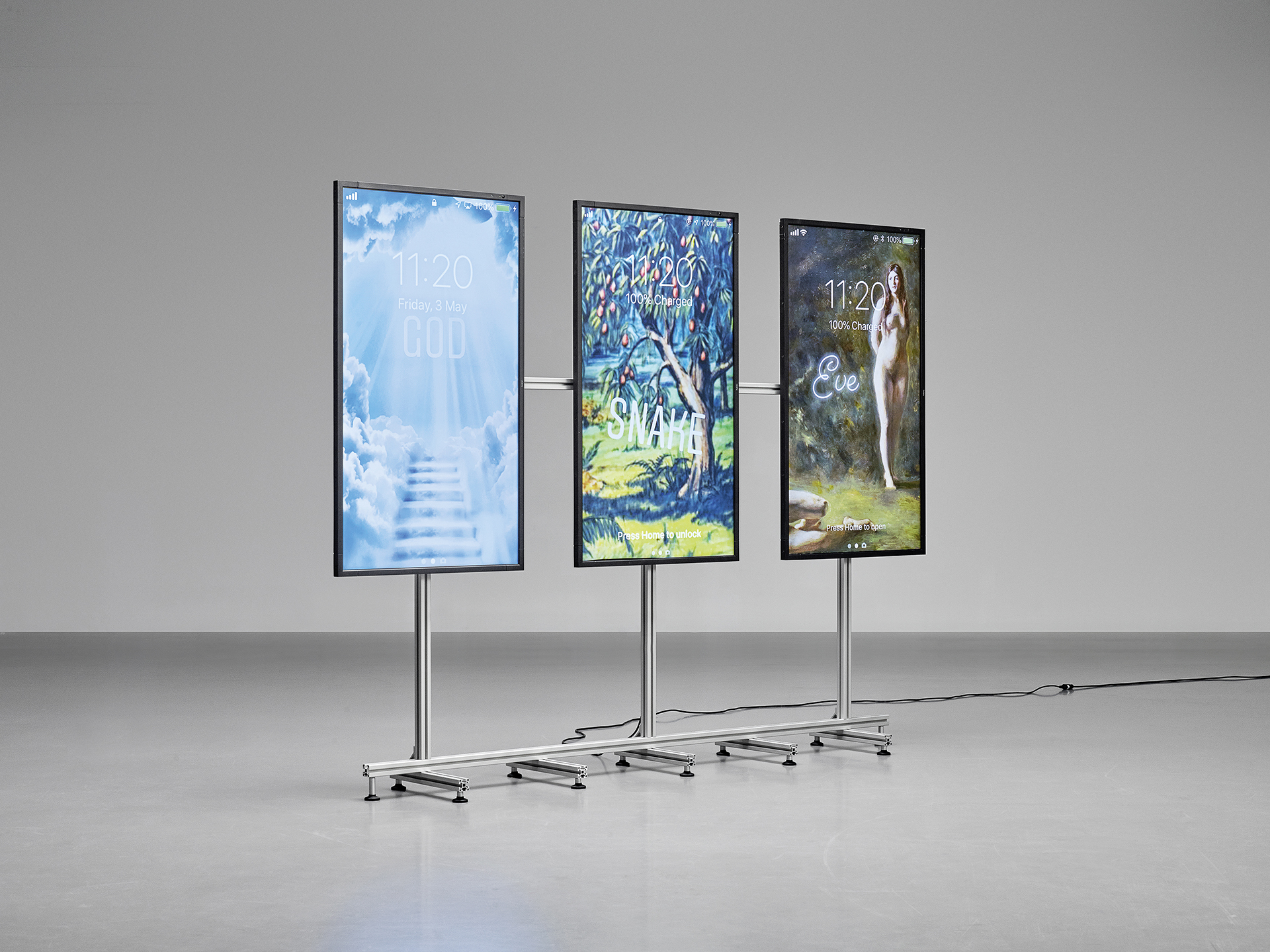
Smartphone Symbiosis Overview
This project tackles how we interact with the data flows to which smartphones give us access. This research through design aims at imagining objects and interfaces allowing a detachment from the smartphone or stimulating a more balanced and focused interaction with some of its functionalities in desired situations. Interfaces are the dominant cultural form of our time. So much of contemporary culture and interactions is taking place through interfaces ; interfaces are part of cultural expression and participation. Therefore, questioning the impact of the mechanisms underlying current smartphone interfaces is also a societal interest. By imagining, designing and prototyping new objects or apparatuses, this project aims to offer proposals for re-appropriation or re-extraction of certain features locked in the smartphone, thereby allowing a different, more customisable access to data or functions, and in turn fostering a shift from the glowing rectangle to a more detached and focused interaction, away from the screen.
Project by : Antoine Barras, Maya Bellier, Pablo Bellon, Ivan Chestopaloff, Bastien Classens, Guillaume Giraud, Léonard Guyot, Evan Kelly, Lisa Kishtoo, Paul Lëon, Kylan Luginbühl, Aurélien Pellegrini, Yaël Sidler, Diane Thouvenin. Teachers : Alain Bellet, Jesse Howard. Assistants : Lison Christe, Martin Hertig.
Medias
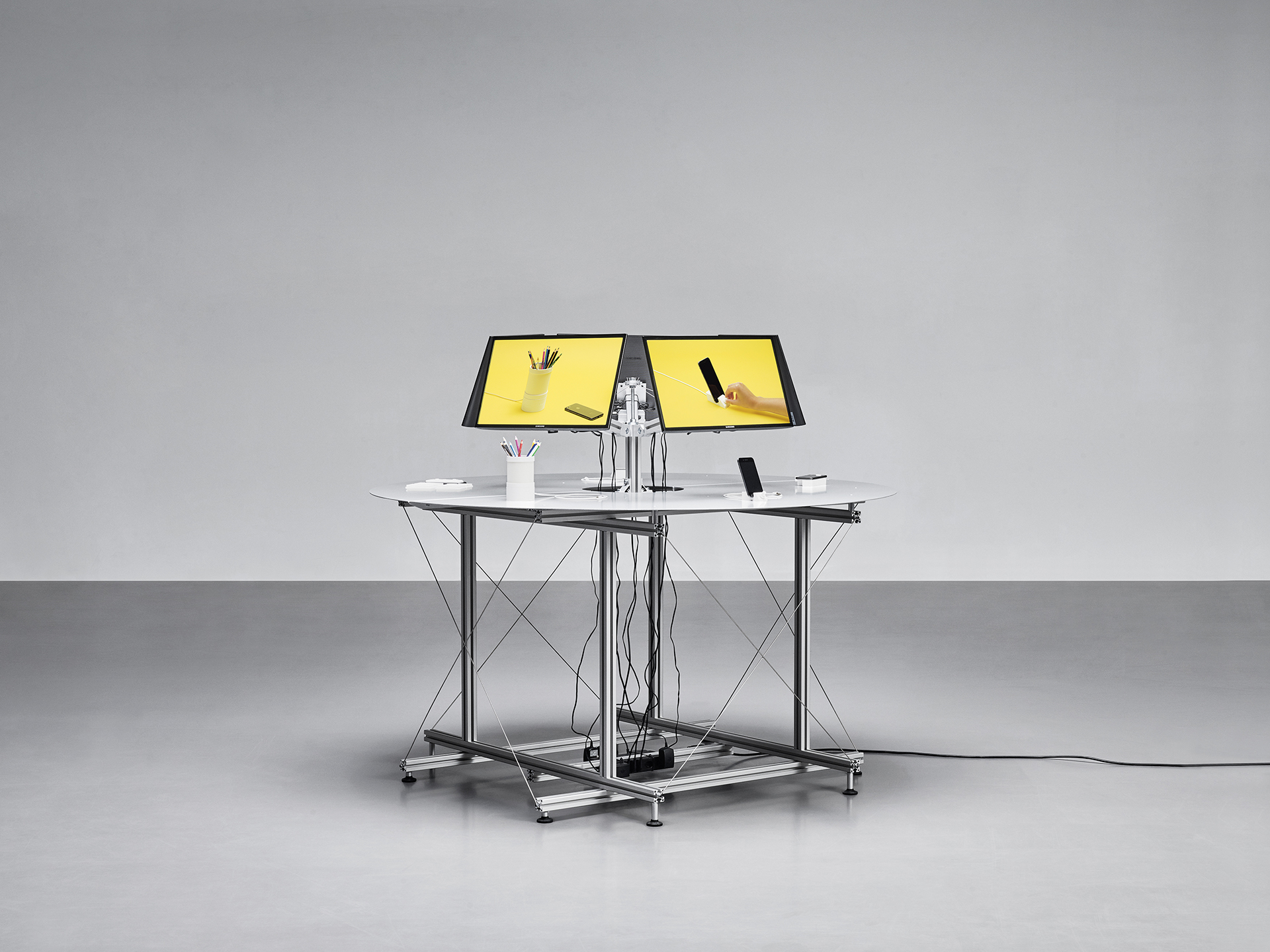
Anti-Stress Case
Do you ever feel stressed by your smartphone? The Anti-Stress Case helps you deal with it. You can switch between various modules with pleasant tactile sensations. The more you play with the case, the less you’ll be annoyed by the notifications.
Project by : Kylan Luginbühl, Aurélien Pellegrini. Teachers : Alain Bellet, Jesse Howard. Assistants : Lison Christe, Martin Hertig.
Medias
.jpg)
Desktop Notifications Center
Desktop Notification Center is a collection of two desktop accessories that provide notifications in the work environment in a way that avoids unnecessary disturbance and stress. Notifica- tions are classified in three categories: Important (calls), Not Urgent (messages), and Futile (social media).
Project by : Pablo Bellon, Ivan Chestopaloff. Teachers : Alain Bellet, Jesse Howard. Assistants : Lison Christe, Martin Hertig.
Medias
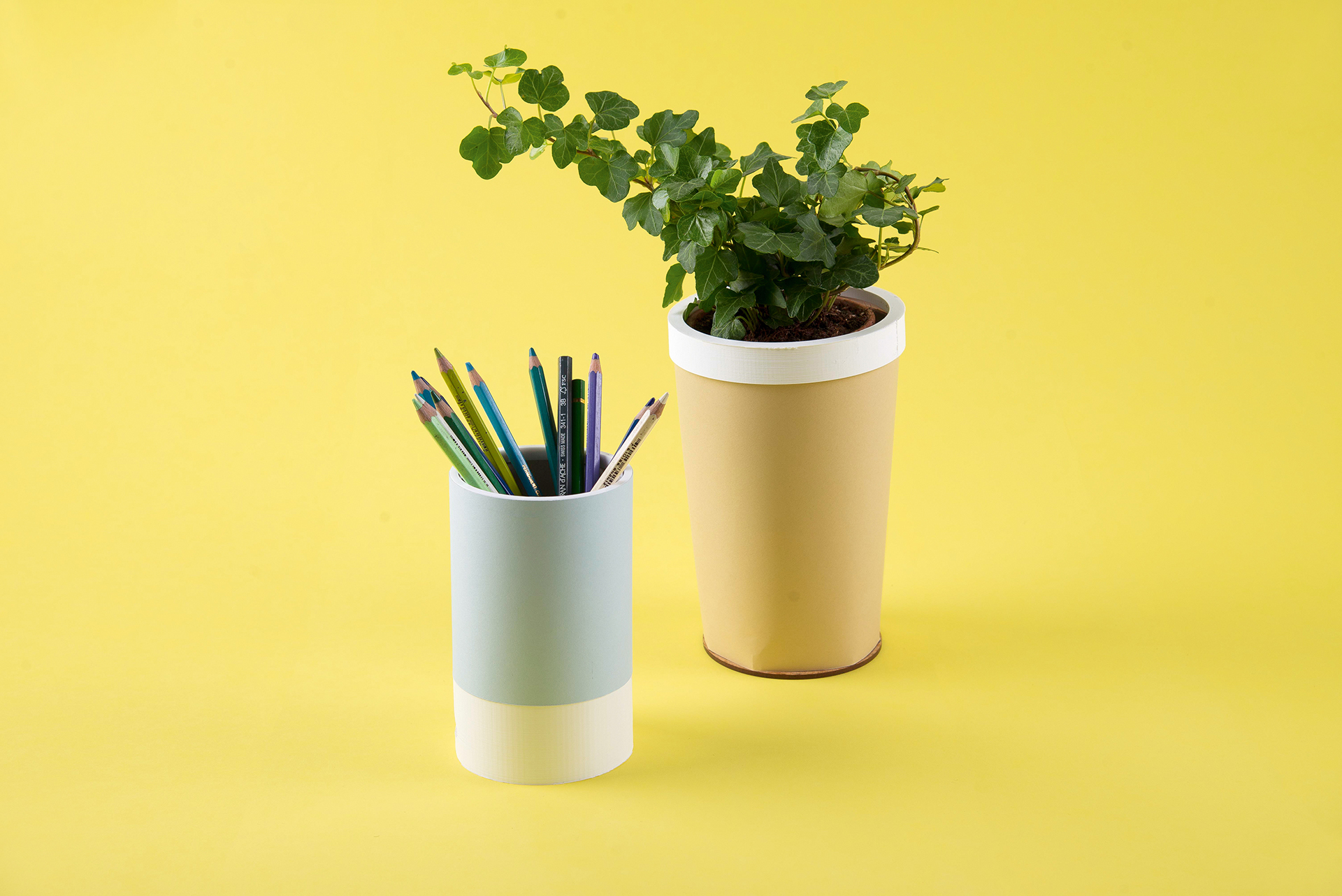
TicTocLock
With technologies such as fingerprint and facial recognition, unlocking the smartphone is becoming faster and less of a conscious gesture. For instance, you only wanted to quickly check the time but find yourself scrolling through social media, even though it wasn’t your initial intention. TicTocLock aims to reinstate a gesture for the unlocking that helps the users take back control over their smartphone activity by physically visualising their usage time.
Project by : Paul Lëon, Diane Thouvenin. Teachers : Alain Bellet, Jesse Howard. Assistants : Lison Christe, Martin Hertig.
Medias

Mistarget
Is your phone spying on you? Mistarget is here to tell you. A lot of people seem to be wondering whether their phone is listening to them for commercial reasons. Some of them even test their phones. We offer a technology that automates the test. When the phone is connected, the dock starts whispering misleading information. Fake conversations about needs and consumerist desires are recorded and stored in the dock. Are the ads going to be affected?
Project by : Antoine Barras, Guillaume Giraud. Teachers : Alain Bellet, Jesse Howard. Assistants : Lison Christe, Martin Hertig.
Medias
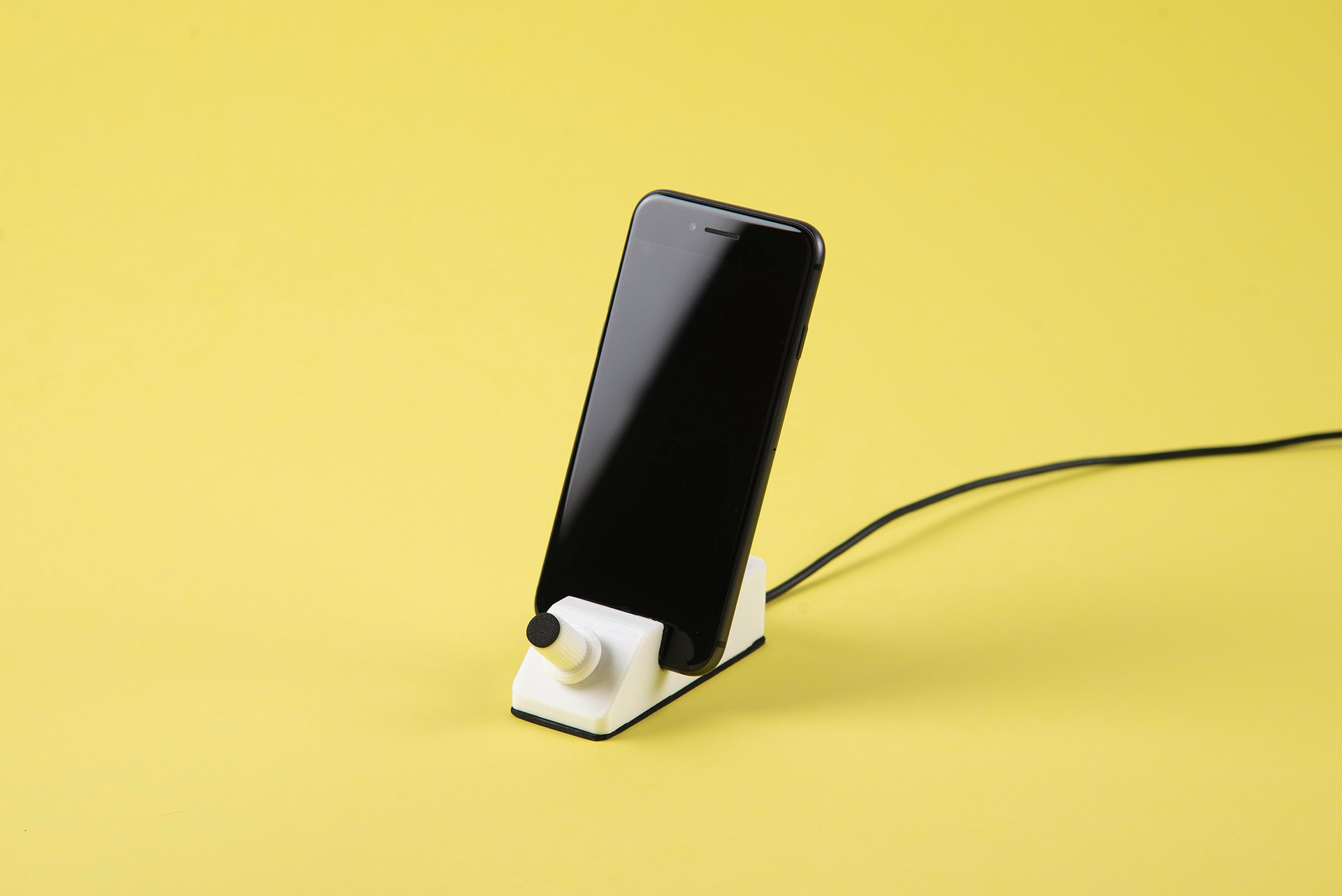
LIA - Leave It Alone
LIA is a smartphone dock that discourages you from constantly checking your phone while working. With its inclined edges, it is impossible to remove the phone from its dock without reason : only receiving priority notifications will make the phone accessible again.
Project by : Bastien Classens, Léonard Guyot. Teachers : Alain Bellet, Jesse Howard. Assistants : Lison Christe, Martin Hertig.
Medias
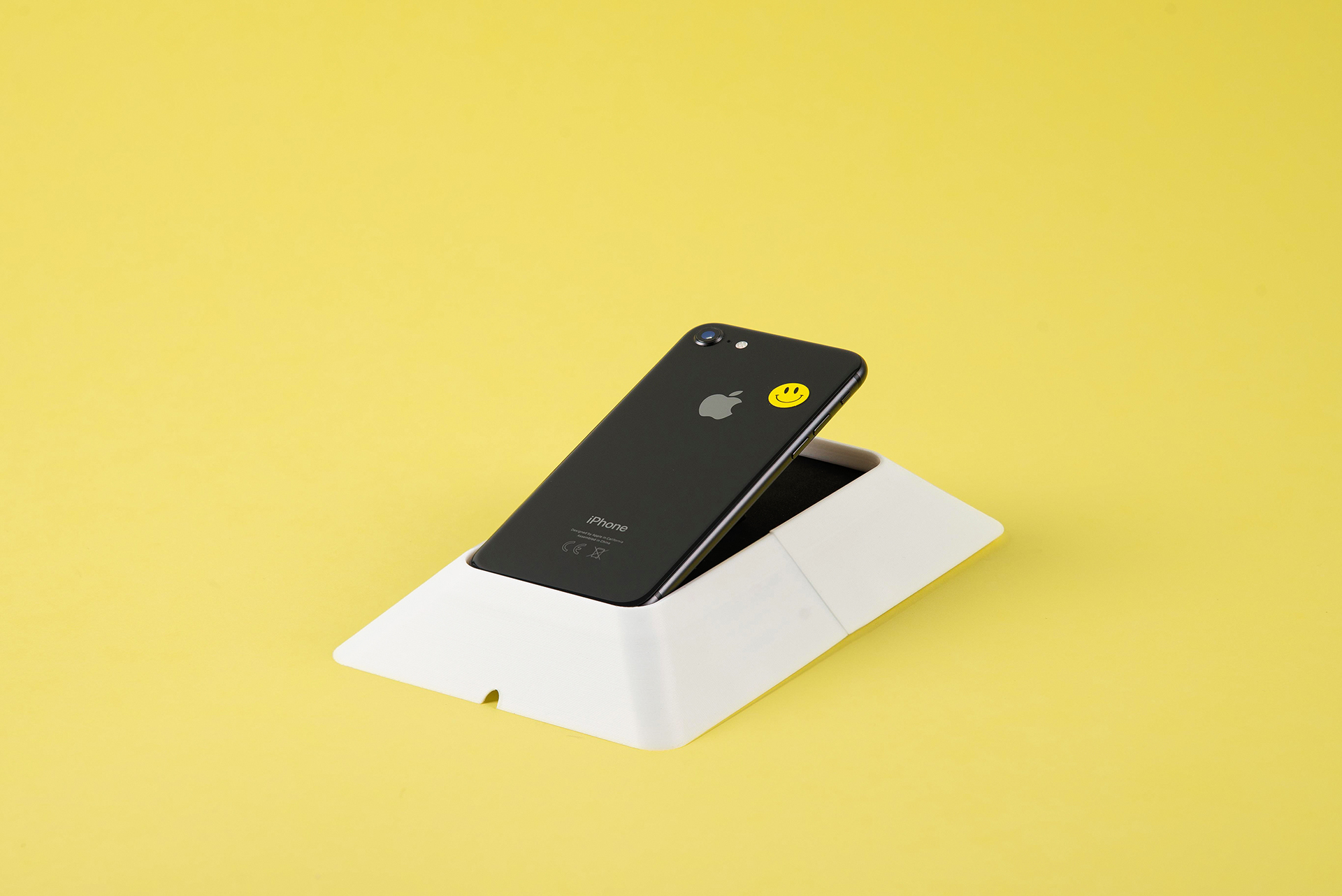
Selfie Robot
Since the appearance of cameras on the front of smartphones, the selfie seems to have become a commonplace act. Both a narcissistic gesture and an artistic act, the selfie questions the notion of representation and reinvents the tradition of the self-por- trait. In recent years, the practice of the selfie has been amplified by the democratisation of the selfie stick, an object that was unknown ten years ago, but the use of which is now part of popular culture. In any given tourist spot, it is sometimes interesting to watch people trying at length to find the perfect position and angle for the perfect photo. But what if a robot grabbed hold of a selfie stick? Selfie Robot is a machine performance featuring a robotic arm equipped with a smartphone and a selfie stick taking pictures of itself with different face filters. As amusing as it is disturbing to see this robot contorting it- self in search of the perfect selfie, it turns us into viewers of the incongruity of our own behaviour.
Project by : Basil Dénéréaz, Sébastien Galera Larios, Rayane Jemaa, Ignacio Pérez. Teachers : Thibault Brevet, Vincent Jacquier, Pauline Saglio. Assistant : Pietro Alberti.
Medias
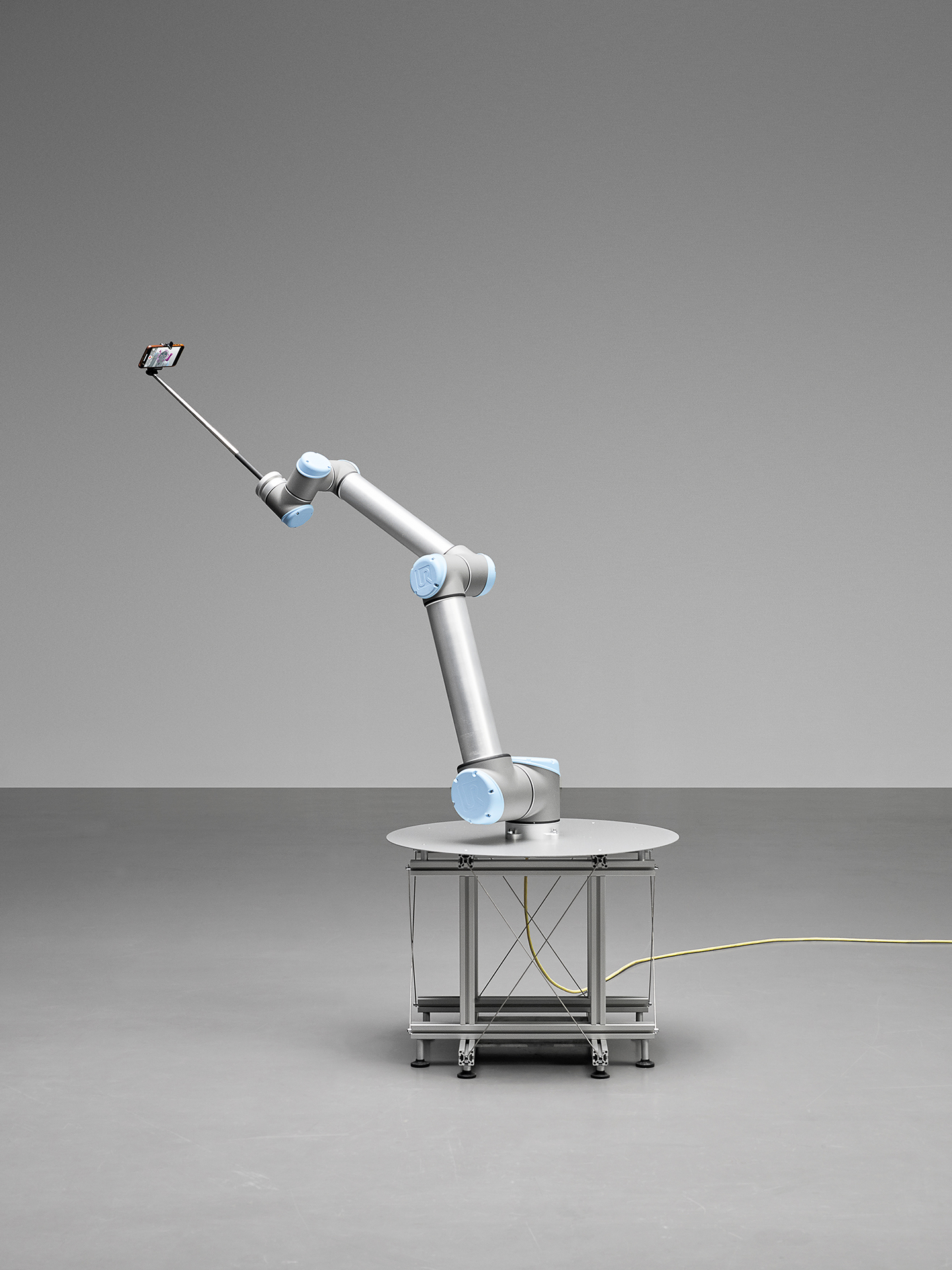
Crédits Projets
Heads of Project : Vincent Jacquier, Pauline Saglio. Head of Visual Communication Department : Vincent Jacquier. Head of Bachelor Media & Interaction Design: Pauline Saglio. Coordination & Development : Lison Christe, Julien Gurtner, Pascal Ospelt, Callum Ross, SIGMASIX, Tibor Udvari. Exhibition Organisation : Antoine Vauthey. Press & Communication : Selim Atakurt. Photography : © ECAL/Jimmy Rachez. Text : Paul Lëon. Graphic Design : Arthur Seguin, Kylan Luginbühl. Movie : Gianni Camporota, Léonard Guyot

